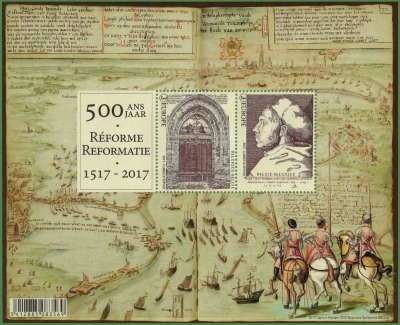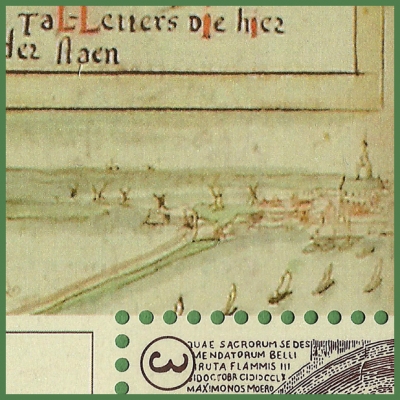-


Number by catalogue: Michel: Bl213
Perforation: Harrow Perforation type: 11 ½x11 ½
Subject:
2 stamps nominated to pay for a letter up to 100 grams in Europe. On the day of release - 3.9 euros (each).
On the stamps depict Martin Luther and the doors of the Church of Wittenberg, where he published out his 95 theses*
The fields of the souvenir sheet are decorated with a reproduction of the engraving of Willem de Gortter: a panorama of the siege of Antwerp in 1584-1585.
Above the first stamp, you can see a few windmills.
Additional:
*In 1516, Johann Tetzel, a Dominican friar and papal commissioner for indulgences, was sent to Germany by the Roman Catholic Church to sell indulgences to raise money in order to rebuild St. Peter's Basilica in Rome. Tetzel's experiences as a preacher of indulgences, especially between 1503 and 1510, led to his appointment as general commissioner by Albrecht von Brandenburg, Archbishop of Mainz, who, deeply in debt to pay for a large accumulation of benefices, had to contribute a considerable sum toward the rebuilding of St. Peter's Basilica in Rome. Albrecht obtained permission from Pope Leo X to conduct the sale of a special plenary indulgence (i.e., remission of the temporal punishment of sin), half of the proceeds of which Albrecht was to claim to pay the fees of his benefices.
On 31 October 1517, Luther wrote to his bishop, Albrecht von Brandenburg, protesting the sale of indulgences. He enclosed in his letter a copy of his "Disputation of Martin Luther on the Power and Efficacy of Indulgences", which came to be known as the Ninety-five Theses. Hans Hillerbrand writes that Luther had no intention of confronting the church, but saw his disputation as a scholarly objection to church practices, and the tone of the writing is accordingly "searching, rather than doctrinaire." Hillerbrand writes that there is nevertheless an undercurrent of challenge in several of the theses, particularly in Thesis 86, which asks: "Why does the pope, whose wealth today is greater than the wealth of the richest Crassus, build the basilica of St. Peter with the money of poor believers rather than with his own money?"
Luther objected to a saying attributed to Johann Tetzel that "As soon as the coin in the coffer rings, the soul from purgatory (also attested as 'into heaven') springs."He insisted that, since forgiveness was God's alone to grant, those who claimed that indulgences absolved buyers from all punishments and granted them salvation were in error. Christians, he said, must not slacken in following Christ on account of such false assurances.
However, this oft-quoted saying of Tetzel was by no means representative of contemporary Catholic teaching on indulgences, but rather a reflection of Tetzel's capacity to exaggerate. Yet, if Tetzel overstated the matter in regard to indulgences for the dead, his teaching on indulgences for the living was in line with Catholic dogma of the time.
According to one account, Luther nailed his Ninety-five Theses to the door of All Saints' Church in Wittenberg on 31 October 1517. Scholars Walter Krämer, Götz Trenkler, Gerhard Ritter, and Gerhard Prause contend that the story of the posting on the door, even though it has settled as one of the pillars of history, has little foundation in truth. The story is based on comments made by Philipp Melanchthon, though it is thought that he was not in Wittenberg at the time.
The Latin Theses were printed in several locations in Germany in 1517. In January 1518 friends of Luther translated the Ninety-five Theses from Latin into German. Within two weeks, copies of the theses had spread throughout Germany; within two months, they had spread throughout Europe.
Luther's writings circulated widely, reaching France, England, and Italy as early as 1519. Students thronged to Wittenberg to hear Luther speak. He published a short commentary on Galatians and his Work on the Psalms. This early part of Luther's career was one of his most creative and productive. Three of his best-known works were published in 1520: To the Christian Nobility of the German Nation, On the Babylonian Captivity of the Church, and On the Freedom of a Christian.
Size (of sheet, booklet) mm: 189x155
500 years of Reformation
Belgium 2017.06.12
In issue: Souvenir sheet(s): 1
Printing: combined gravure and intaglio